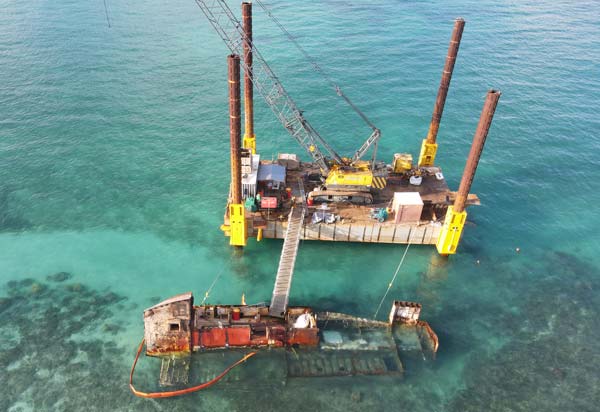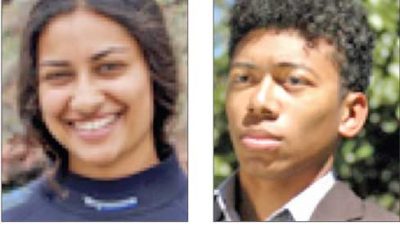PCRP completes removal of derelict vessel from Saipan Lagoon

This file photo show work being done to salvage the derelict Lady Carolina. Photo taken by licensed commercial drone pilot BJ Eddy. Check out his YouTube channel: https://youtu.be/mydiGis7xwY. (BJ EDDY)
Removing the grounded vessel took two months and succeeded in eliminating approximately 90 tons of scrap steel and 75 gallons of fuel from the lagoon environment.
Pacific Coastal Research & Planning, a Saipan-based environmental non-profit organization, announced Friday the successful completion of the project to remove the derelict fishing vessel, Lady Carolina, from the Saipan Lagoon.
The Lady Carolina was an 83-foot, 54-ton, steel-hulled fishing vessel that had been grounded in a shallow, highly visible area of the Saipan Lagoon since it broke free of its mooring during the devastating passing of category 4 Typhoon Soudelor in August 2015. The vessel was further damaged during Typhoon Yutu in 2018.
This removal project was funded by the National Oceanic and Atmospheric Administration’s Marine Debris Program and the National Fish and Wildlife Foundation.
The removal activity was conducted by Smithbridge Guam with support from Tano Group, Inc. and Deep Blue LLC. Johnston Applied Marine Sciences and Koa Consulting provided environmental monitoring and compliance support to the project. This project also received continuous support from local government agencies, including the Commonwealth Ports Authority, Bureau of Environmental Coastal Quality’s Division of Coastal Resources Management and Division of Environmental Quality, and the Department of Lands and Natural Resources and DLNR-Division of Fish and Wildlife.
The removal commenced on May 24, 2021, with the mobilization of the Smithbridge crane and jackup barge out to the wreck site. Smithbridge and Tano crew members worked to cut the Lady Carolina wreck into smaller pieces that were then lifted by the crane onto a waiting transport vessel. The pieces were then transported to Saipan, where Deep Blue LLC secured the pieces and took them to their construction yard for further breakdown, processing, and disposal.
Community members interested in viewing a progression story map of the Lady Carolina’s removal can do so at PCRP’s website: https://www.pacificcrp.org/lady_carolina
In total, Deep Blue LLC project managers recorded and disposed of: 87.9 tons (+/- 5%) of metal scrap (black iron, stainless steel, and some copper/aluminum), 864 cubic feet of common waste (wood, plastic, etc.), and 980 cubic feet of other waste (rigid foam insulation). In addition, the Smithbridge-Tano crew recovered approximately 650 gallons of rainwater mixed with diesel and other residual fuels from inside three separate previously sealed and elevated holds. All oily water was immediately contained and transferred into 13 55-gallon drums before being transported back to Saipan and disposed of at a BECQ-permitted used oil burning facility. The discovery of this fuel/lubricant further justifies the need for this removal project before the Lady Carolina was further damaged and the contaminants were released into the surrounding environment.
In order to minimize the negative effects of the removal process on the local environment, before the removal project began the marine biologist team under JAMS translocated approximately 150 coral colonies from the removal project area and secured them to a temporary staging area nearby. Following the demobilization of the Smithbridge equipment, JAMS reattached these coral colonies to the reef substrate at the removal site. By returning these corals to the vessel “scar,” we hope to help jumpstart the recovery process for the reef habitat damaged by the vessel grounding. In addition, JAMS removed approximately 400 lbs of small metal, plastic, and glass debris from the removal site.
Saipan-based environmental consulting company Koa Consulting was contracted to implement the “Lady Carolina Removal Water Quality Monitoring Plan/Program” as required by the Division of Environmental Quality to meet the U.S. Clean Water Act 401 Water Quality Certification Requirements. This included daily routine and response monitoring of the entire water column at multiple locations surrounding the project sight using visual and real-time multi-parameter water quality data logging instrumentation (YSI model Pro DSS) to assess the following: pH, turbidity, Total Suspended Solids, hydrocarbons (e.g. fuel, oil, lubricants), tannins and paint, and debris. As reported by Koa Consulting, none of the field measured water quality parameters exceeded allowable variances throughout the duration of the project.
Upon the completion of this project, Mark Manuel, NOAA Marine Debris Program Pacific Islands Regional Coordinator released the following statement: “The NOAA Marine Debris Program is very proud to support the removal of the Lady Carolina. It has continued to serve as an unfortunate reminder of the destruction of Typhoon Soudelor and Typhoon Yutu, while posing a hazard to waterways, wildlife, and community members. Removing abandoned and derelict vessels such as this are important for the preservation of our ecological, cultural, and economic resources. Keeping CNMI free from the impacts of marine debris is important, and we look forward to continuing to work collaboratively with local partners to address this issue.”
Removing the grounded vessel will prevent further environmental impacts to sensitive habitat, such as coral reefs, and endangered species. The Lady Carolina was one of many abandoned and derelict vessels in the CNMI. ADVs can obstruct navigational channels, damage ecosystems, and diminish the recreational value of the surrounding areas. ADVs are difficult and expensive to remove and therefore may persist for years, breaking apart and creating widespread debris fields that threaten marine and coastal environments. Most of the ADVs in the CNMI, including the Lady Carolina, are a result of typhoons. PCRP would like to remind boat owners in the CNMI to practice storm preparedness and properly secure vessels and equipment in order to prevent additional ADVs and marine debris.
For more information on the removal of the Lady Carolina and project activities, visit PCRP’s website at pacificcrp.org or contact Becky Skeele, executive director of Pacific Coastal Research & Planning, at becky.skeele@pacificcrp.org. (PR)

























